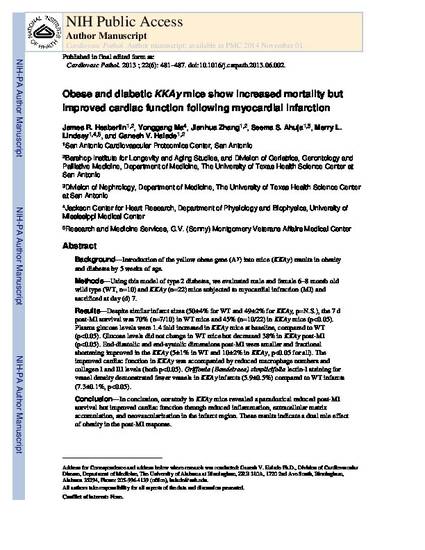
- Diabetes,
- Extracellular matrix,
- Heart failure,
- Inflammation,
- Myocardial infarction,
- Obesity
Background: Introduction of the yellow obese gene (Ay) into mice (KKAy) results in obesity and diabetes by 5 weeks of age. Methods: Using this model of type 2 diabetes, we evaluated male and female 6-to 8-month-old wild-type (WT, n=10) and KKAy (n=22) mice subjected to myocardial infarction (MI) and sacrificed at day (d) 7. Results: Despite similar infarct sizes (50%±4% for WT and 49%±2% for KKAy, P=not significant), the 7d post-MI survival was 70% (n=7/10) in WT mice and 45% (n=10/22) in KKAy mice (P < .05). Plasma glucose levels were 1.4-fold increased in KKAy mice at baseline compared to WT (P < .05). Glucose levels did not change in WT mice but decreased 38% in KKAy post-MI (P < .05). End-diastolic and end-systolic dimensions post-MI were smaller and fractional shortening improved in the KKAy (5%±1% in WT and 10%±2% in KKAy, P < .05 for all). The improved cardiac function in KKAy was accompanied by reduced macrophage numbers and collagen I and III levels (both P < .05). Griffonia (Bandeiraea) simplicifolia lectin-I staining for vessel density demonstrated fewer vessels in KKAy infarcts (5.9%±0.5%) compared to WT infarcts (7.3%±0.1%, P < .05). Conclusion: In conclusion, our study in KKAy mice revealed a paradoxical reduced post-MI survival but improved cardiac function through reduced inflammation, extracellular matrix accumulation, and neovascularization in the infarct region. These results indicate a dual-role effect of obesity in the post-MI response.
Cardiovascular Pathology, v. 22, issue 6, p. 481-487
This article is the post-print author version. Final version available at: https://doi.org/10.1016/j.carpath.2013.06.002
Available at: http://works.bepress.com/ganesh-halade/62/